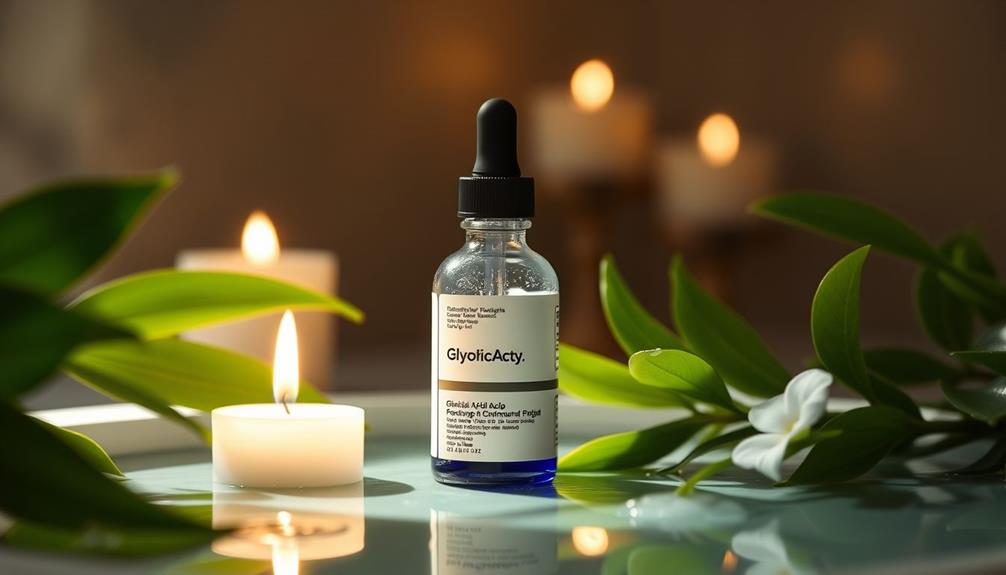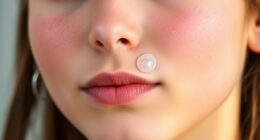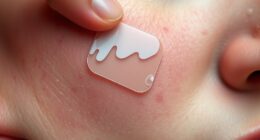Glycolic acid is a game-changer for your skincare routine. This powerhouse ingredient exfoliates by removing dead skin cells, revealing a brighter and smoother complexion. It's known for reducing fine lines and hyperpigmentation, making your skin look youthful and radiant. Plus, it tackles acne by unclogging pores and helping to fade scars. With regular use, you'll notice significant improvements in texture and overall skin tone. Just remember to start with lower concentrations and gradually increase use to avoid irritation. Explore how integrating glycolic acid into your regimen can transform your skin further!
Key Takeaways
- Glycolic acid enhances exfoliation, revealing brighter skin and improving texture by effectively dissolving bonds between dead skin cells.
- It stimulates collagen production, reducing fine lines and wrinkles, thereby providing significant anti-aging benefits.
- Glycolic acid unclogs pores, making it an effective treatment for acne and helping to minimize acne scars for an even skin tone.
- It addresses hyperpigmentation and dark spots, contributing to a more uniform and radiant complexion over time.
What Is Glycolic Acid?
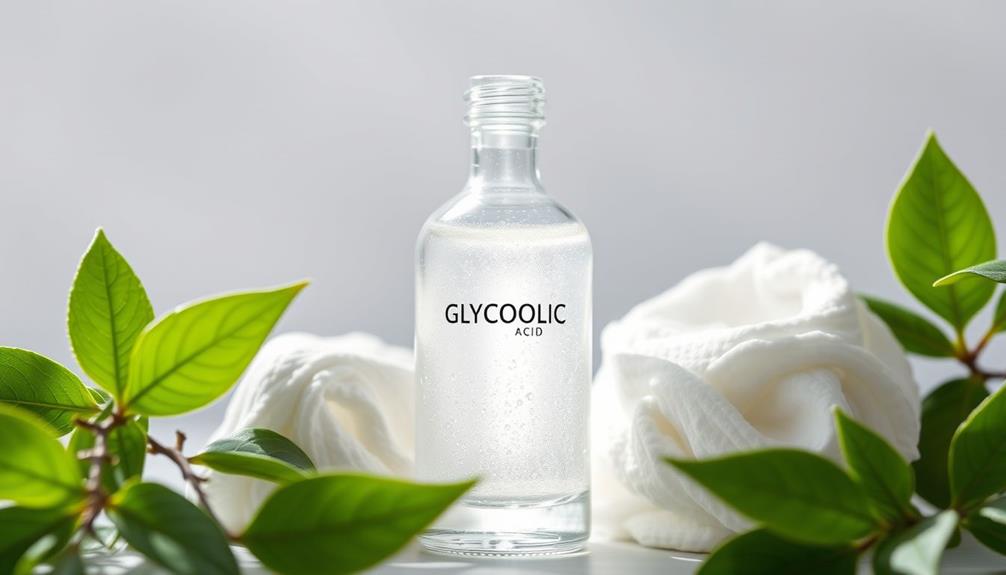
Glycolic acid, a powerful alpha-hydroxy acid derived from sugarcane, deeply penetrates the skin to promote effective exfoliation and reveal a brighter complexion. This small-molecule acid works by dissolving the bonds that hold dead skin cells together, making it easier for your skin to shed these cells and encourage cellular turnover. As you incorporate glycolic into your routine, you'll notice improved skin texture and a more radiant complexion.
Additionally, the use of natural alternatives like essential oils for skin health can complement glycolic acid treatments for enhanced results.
Regular use of glycolic acid can stimulate collagen production, which is essential for keeping your skin firm and elastic. This makes it a fantastic option for those looking to reduce fine lines and wrinkles. Additionally, glycolic acid helps diminish dark spots and hyperpigmentation, making your skin tone appear more even and youthful over time.
You'll find glycolic acid in a variety of skincare products, such as cleansers, toners, serums, and chemical peels. Each of these products offers a different way to experience the benefits of this powerful alpha-hydroxy acid. By choosing the right products, you can effectively harness glycolic acid's potential for a healthier, more vibrant complexion.
Key Benefits for Your Skin

Experience a multitude of key benefits for your skin with glycolic acid, including enhanced exfoliation, reduced fine lines, and improved overall radiance.
This powerful ingredient effectively exfoliates dead skin cells, revealing brighter skin and improved skin texture. As you incorporate glycolic acid into your routine, you'll notice a significant reduction in the appearance of fine lines, thanks to its ability to stimulate collagen production, giving you a more youthful complexion.
Additionally, just as certain essential oils, like lavender, promote skin health through natural healing properties, glycolic acid can enhance your skincare regimen aromatherapy benefits.
Glycolic acid also excels at unclogging pores, which helps reduce acne breakouts and prevent future breakouts, making it a go-to for those struggling with blemishes.
Over time, it can even help heal and minimize the appearance of acne scars, promoting an even skin tone. Additionally, it addresses hyperpigmentation and dark spots, ensuring you achieve that sought-after glow.
With its small molecular size, glycolic acid penetrates deeper into the skin than other alpha-hydroxy acids, delivering visible results more effectively.
Regular use of glycolic acid can truly transform your skin, enhancing its health and beauty while promoting a radiant, youthful appearance.
How Glycolic Acid Works
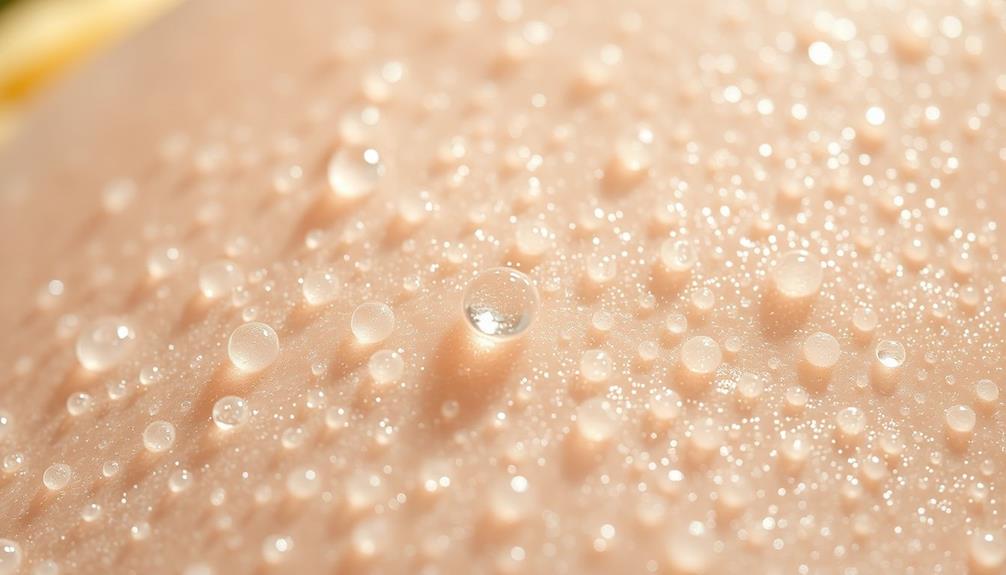
By breaking down the bonds between dead skin cells, glycolic acid facilitates effective exfoliation and promotes skin renewal.
Its unique exfoliating properties allow it to penetrate deeper than other alpha-hydroxy acids, making it a powerhouse for improving skin texture.
When you use glycolic acid, you're not just removing dead skin cells; you're also encouraging cell turnover, leading to a brighter and clearer complexion.
Incorporating a balanced diet rich in vitamins can further enhance your skin's appearance and support overall health.
With regular use, glycolic acid helps reduce the appearance of fine lines and wrinkles, giving your skin a smoother look.
It's particularly effective at unclogging pores, which can help prevent acne breakouts and keep your skin looking fresh.
You can find glycolic acid in various formulations, such as serums and peels.
A hydrating serum containing glycolic acid can enhance moisture retention while still delivering its exfoliating benefits.
Whether you opt for lower concentrations for daily use or higher strengths for targeted concerns, incorporating glycolic acid into your routine can greatly benefit your skin.
Embrace the power of glycolic acid, and enjoy the rejuvenating effects it brings to your skincare regimen.
Safe Usage Guidelines
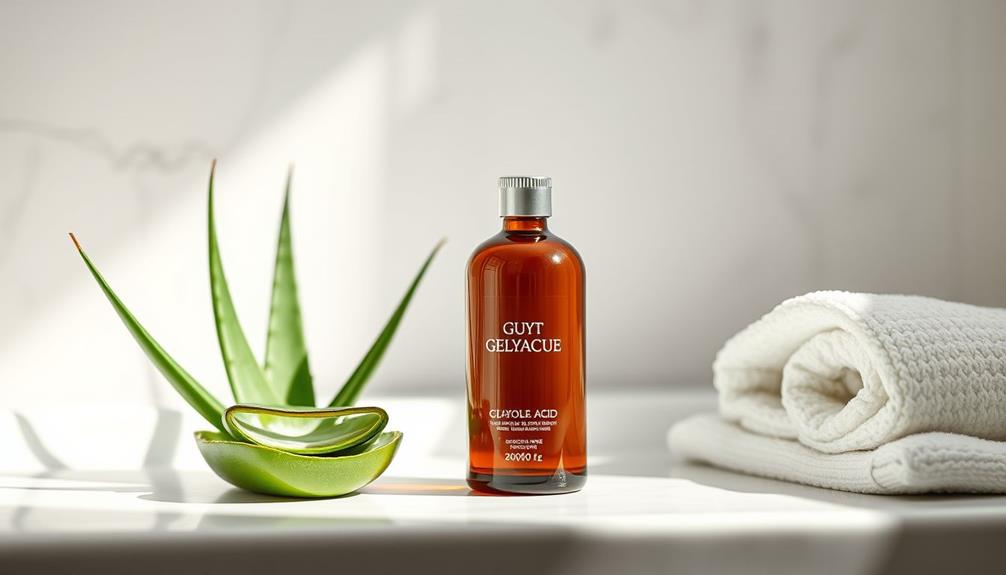
When you start using glycolic acid, it's best to begin with a low concentration of 5-10% and limit your applications to 1-2 times a week.
To optimize your skincare routine, consider incorporating regular physical activity, as it can enhance skin health and overall well-being.
Additionally, practicing mindful eating practices can improve your skin's appearance from within.
Pay close attention to how your skin reacts, as this will help you determine the right frequency for your routine.
Adjust your usage based on any signs of irritation to keep your skin healthy and happy.
Start With Low Concentration
Starting with a low concentration of glycolic acid, typically between 5-10%, helps guarantee your skin can tolerate the treatment while minimizing irritation. This approach allows your skin to gradually adjust, reducing the chances of adverse reactions.
Here are some tips to safely incorporate glycolic acid into your evening skincare routine:
- Conduct a patch test: Apply a small amount on a discreet area of your skin and wait 24 hours to check for any negative reactions.
- Use it sparingly: Start with glycolic acid 1-2 times per week. This frequency helps your skin adapt without overwhelming it, allowing you to monitor how your skin reacts.
- Watch for redness and irritation: If you notice any signs of discomfort, adjust usage accordingly. This will help prevent over-exfoliation and potential photosensitivity.
Monitor Skin Reactions
Monitoring skin reactions is vital to guaranteeing a safe and effective experience with glycolic acid, allowing you to adjust your regimen based on your skin's response.
Start with a low concentration of glycolic acid (5-10%) and limit your frequency of application to 1-2 times per week. This approach helps you gauge your skin tolerance without overwhelming it.
Before applying glycolic acid on your entire face, conduct a patch test on a small area of skin. This step is essential for identifying any potential adverse reactions, especially if you have sensitive skin.
Keep an eye out for common skin reactions, such as redness, peeling, and irritation. If you notice any severe irritation, discontinue use immediately, as over-exfoliation can lead to dryness and increased sensitivity.
To maintain a healthy skincare routine, make sure you're moisturizing adequately after using glycolic acid.
Gradually introducing this active ingredient into your routine can minimize skin reactions while maximizing its benefits.
Always listen to your skin, and adjust your usage based on how it responds to the glycolic acid. This careful monitoring will help you achieve the best results without compromising your skin's health.
Potential Side Effects
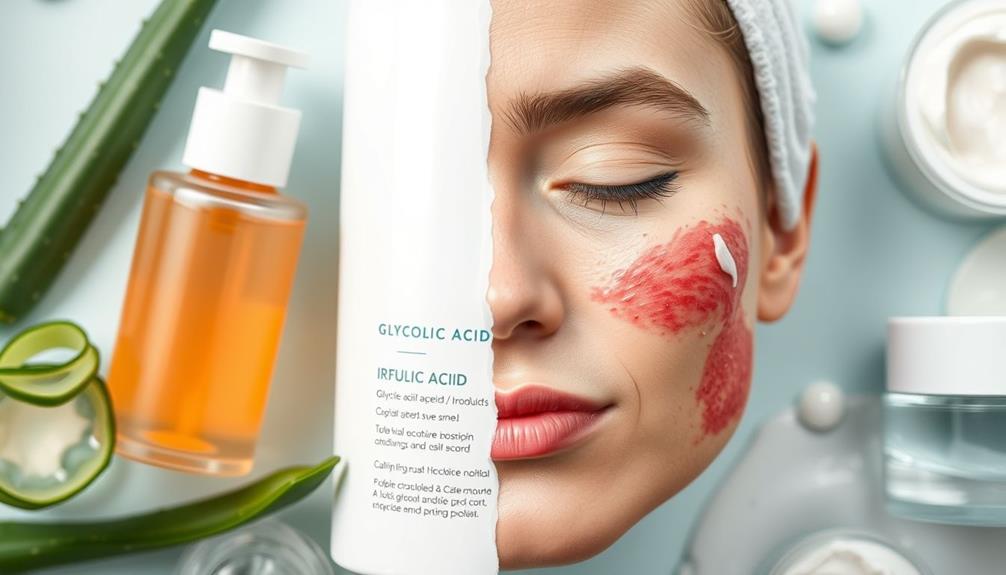
When using glycolic acid, you might experience common reactions like redness, peeling, or irritation, especially if your skin is sensitive.
It's crucial to manage your skin's sensitivity and avoid over-exfoliation by starting with lower concentrations and gradually increasing use.
If you notice severe irritation, don't hesitate to stop using it and consult a dermatologist for advice.
Common Reactions to Usage
Common reactions to glycolic acid usage can include mild redness, peeling, and irritation, especially for those with sensitive skin. During the initial adjustment period, often referred to as "purging," you might notice red bumps as your skin begins to renew itself. This phase can last from 2 to 6 weeks, so it's vital to be patient.
Here are some common reactions you might experience:
- Mild Redness: This is typically temporary and should fade as your skin adjusts.
- Peeling: Some flaking or peeling is normal as the glycolic acid promotes skin cell turnover.
- Irritation: If you notice increased sensitivity, it may be a sign that you're using a concentration that's too high for your skin.
To minimize these reactions, start with lower concentrations (5-10%) and gradually increase usage based on your skin's tolerance.
However, if you experience severe irritation, it's important to discontinue use and consult a dermatologist for tailored advice.
Managing Skin Sensitivity
Managing skin sensitivity while using glycolic acid is essential to achieving desired results without adverse effects. Start with a low concentration, ideally between 5-10%, and always conduct a patch test before applying it to your entire face. This approach helps minimize the risk of irritation, especially if you have sensitive skin.
Gradually increase the frequency of use; begin with 1-2 times a week to allow your skin to adapt. This gradual introduction can considerably reduce skin sensitivity and irritation. If you notice any severe reactions, such as redness or peeling, be sure to monitor your skin response closely. Discontinue use if irritation persists, as over-exfoliation can lead to dryness and heightened sensitivity.
Avoid combining glycolic acid with other potent exfoliants like retinol or salicylic acid, as this can exacerbate irritation. Instead, focus on hydrating your skin to counteract any dryness.
Avoiding Over-Exfoliation Risks
Over-exfoliating with glycolic acid can severely compromise your skin barrier, leading to heightened sensitivity, redness, and irritation. It's vital to recognize the potential side effects of overuse to maintain a healthy complexion.
Here are three key risks to watch out for:
- Increased Sensitivity: Excessive glycolic acid can lead to a more reactive skin barrier, making your skin prone to irritation and discomfort.
- Peeling and Dryness: You might experience peeling and excessive dryness, particularly if your skin is already sensitive. This can undermine your skincare routine and leave your skin looking dull.
- Compromised Skin Tolerance: Using glycolic acid too frequently can reduce your skin's tolerance, making it harder for you to incorporate other beneficial products in your regimen.
To avoid these issues, start with lower concentrations (5-10%) and limit applications to 1-2 times weekly. By monitoring your skin's response and adjusting the frequency as needed, you can prevent over-exfoliation and guarantee your skin remains healthy and resilient.
Always discontinue use if you notice severe irritation to allow your skin to recover properly.
Choosing the Right Product
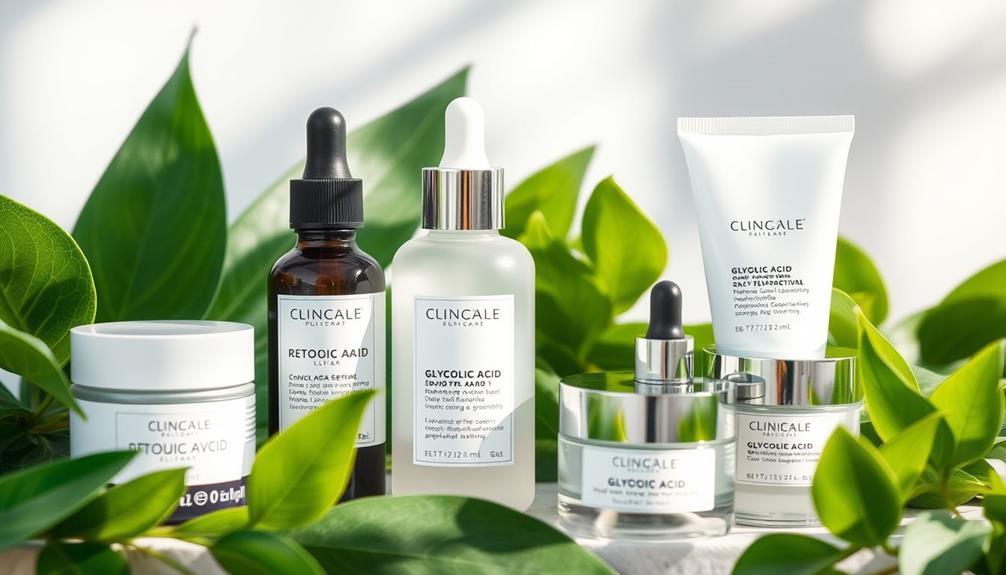
When selecting a glycolic acid product, it's crucial to match the formulation to your specific skin type for best results.
If you have oily skin, look for products with higher concentrations of glycolic acid and additional acne-fighting ingredients like salicylic acid.
For dry skin, choose formulations with hydrating components to prevent irritation and support your moisture barrier.
Start with a lower concentration of glycolic acid, around 5-10%, to assess your skin tolerance. This way, you can gradually increase the concentration as your skin adapts, enhancing exfoliation and overall results.
If you have sensitive skin, opt for gentle formulations with lower concentrations, and limit usage to once or twice a week to minimize irritation.
Normal and combination skin types can benefit from moderate concentrations, balancing effective exfoliation while maintaining the skin's moisture barrier.
Always check for additional beneficial ingredients in glycolic acid products, such as antioxidants and peptides, to enhance overall effectiveness and skin health.
Incorporating Glycolic Acid
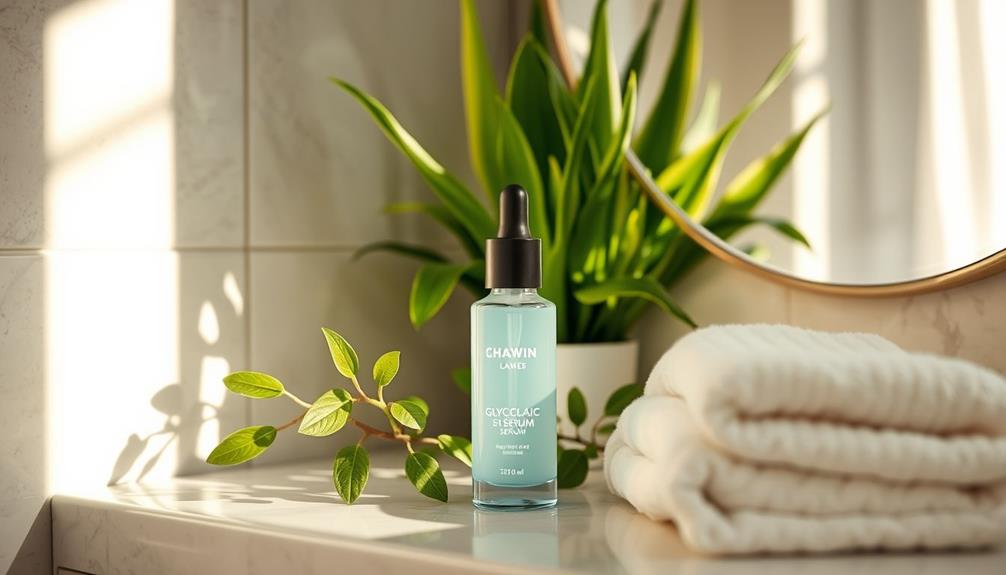
Incorporating glycolic acid into your skincare routine can greatly enhance your skin's texture and appearance. Start slowly with a low concentration (5-10%) to see how your skin tolerates it. Here are three key steps to follow:
- Cleansing: Use a glycolic acid cleanser 2-3 times a week. This helps with exfoliation, unclogs pores, and promotes a brighter complexion. It's especially beneficial for acne-prone skin.
- Evening Application: Apply glycolic acid products at night. This reduces the risk of irritation and allows the acid to work effectively while you sleep. It also helps combat signs of aging and improves skin tone.
- Moisturizing: After cleansing, apply a hydrating serum or moisturizer. This step is essential for maintaining skin health, preventing dryness, and supporting your skin barrier function.
Regular use of glycolic acid encourages cell turnover, leading to improved clarity and a more even complexion. You'll notice a reduction in the appearance of fine lines and hyperpigmentation over time.
Get ready to enjoy the transformative effects glycolic acid can bring to your skincare routine!
Long-term Skin Improvements

Regularly using glycolic acid can lead to remarkable long-term improvements in your skin's texture and overall appearance. By promoting cell turnover, glycolic acid helps you achieve a smoother and more radiant complexion over time. This powerful ingredient not only enhances skin texture but also reduces the appearance of fine lines and wrinkles by stimulating collagen production, resulting in firmer, youthful skin.
Additionally, glycolic acid effectively fades hyperpigmentation and dark spots through consistent exfoliation. As you incorporate it into your routine, you'll notice enhanced skin clarity and brightness. Many users experience a significant reduction in acne, as glycolic acid unclogs pores and prevents the buildup of dead skin cells, leading to fewer breakouts.
With consistent use, glycolic acid can improve skin tone uniformity and radiance, contributing to a healthier and more luminous appearance. The long-term benefits are undeniable; your skin won't only look better but also feel healthier. As you embrace glycolic acid, you're investing in the overall health and importance of your skin, ensuring that it remains vibrant and youthful for years to come.
Conclusion
Incorporating glycolic acid into your skincare routine can truly transform your complexion.
It's amazing how a simple ingredient can lead to clearer, smoother skin while tackling issues like dullness and uneven texture.
You might find that as you embrace this powerhouse, other aspects of your self-care routine also begin to flourish.
Just like your skin, your confidence can thrive simultaneously, creating a beautiful coincidence that underscores the power of consistent, effective skincare.
Embrace the change!


